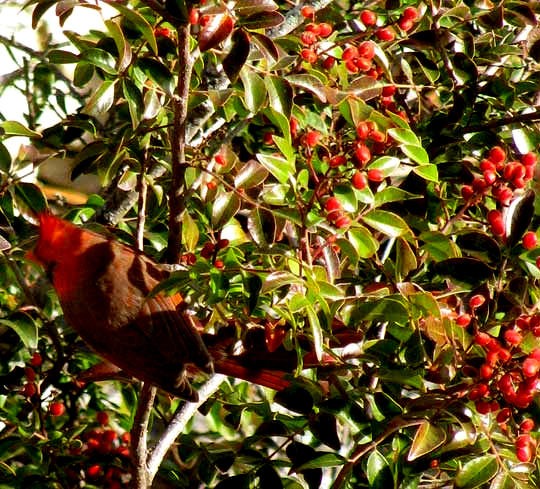Excerpts from Jim Conrad's
Naturalist Newsletter

from the October 27, 2013 Newsletter issued from the Frio Canyon Nature Education Center in the valley of the Dry Frio River in northern Uvalde County, southwestern Texas, on the southern border of the Edwards Plateau; elevation ~1750m (~5750 ft); N29.62°, W99.86°; USA
EVERGREEN SUMAC
Here in late October I was astonished to see leaning from the woods edge at the side of a road a ten-ft-tall (3m) bush or small tree absolutely loaded with dense clusters of small, white flowers abuzz with bees. Above, you can see the tree's shiny, dark green, pinnately compound leaves arising one leaf per stem node (alternate) beneath a branch-tip inflorescence A close-up of a flower with its five white petals and five stamens is shown below:

In this part of the world there aren't too many shrubs or trees with alternate, pinnately compound leaves and flowers looking like these. You might think of Soapberries, but we saw them flowering in mid summer in more diffuse panicles. There's Tickletongue, in the Citrus Family, but that's spiny and its leaves are smaller. Coming from the East, my first thought was that it looked a little like a sumac, but I'm used to sumacs having smaller flowers and leaves not nearly as shiny and leathery as these apparently evergreen ones. But what could it be if not a sumac?
Back at the computer, the University of Texas's dandy Flora of Texas Database at http://orchid.biosci.utexas.edu/Texas_II.html informed me that in Uvalde County at least three sumac species -- members of the genus Rhus -- have been recorded, and when I did an image search on the three species, one of them looked exactly like our late-flowering friend.
It was RHUS VIRENS, known as the Evergreen or Tobacco Sumac, mostly of the north Mexican arid lands, but entering the US in an area from southern Arizona to central Texas. Literature indicates that in Texas the species flowers in July and August, but ours in late October simply couldn't have been more at its flowering peak. Its habitat preferences are described as rocky hillsides, gullies and bluffs.
Evergreen Sumac's flowers are unisexual, each sex appearing on a different tree -- the plants are dioecious. I think our picture must show male flowers, for in other pictures of flowers often the ovary is more apparent and the stamens are smaller.
The 2010 book Uses and Abuses of Plant-Derived Smoke: Its Ethnobotany as Hallucinogen, Perfume, Incense, and Medicine by Marcello Pennacchio and others reports that in our area indigenous Americans smoked Evergreen Sumac's leaves and mixed them with tobacco, though it's not said whether the effects were hallucinogenic. St. Edward's University of Austin, Texas, produces a webpage on which it's claimed that Evergreen Sumac's fruits are tasty but very tart, and that its leaves can be made into a tea to help with stomach pain. Though I'm wary of such a tea since sumacs belong to the Poison Ivy Family and some sumac species cause skin problems, later in the season if I can find some berries I'll certainly give it a try.
from the December 22, 2013 Newsletter issued from the Frio Canyon Nature Education Center in the valley of the Dry Frio River in northern Uvalde County, southwestern Texas, on the southern border of the Edwards Plateau; elevation ~1750m (~5750 ft); N29.62°, W99.86°; USA
EVERGREEN SUMAC FRUITING
The other day I peeped over a limestone ledge beside the Dry Frio and saw the pretty picture shown below:

I'd been looking for an Evergreen Sumac with fruits because the literature reports that the fruits can be soaked in water to produce a tart tea. Back East I've often made tea with the Staghorn Sumac's red fruits, which are covered with glandular hairs. When those fruits are placed in hot water the glands burst releasing acid into the water, which tastes good, a bit like lemonade.
However, this tree was inaccessibly clinging to a cliff face so I'll have to wait to try that.
There's the matter of how to pronounce "sumac." I was taught to call it SHU-mak, and the online Merriam-Webster Dictionary gives that as the first pronunciation, with SU-mak the second. Other dictionaries usually say the same. When I was a kid "SU-mak" was regarded as absolutely wrong, pronounced that way only by people who didn't know how to say it, and were pronouncing it as its spelling suggests, which was as "wrong" as pronouncing "knight" the way it looks. Nowadays so few people have connections with grandparents who grew up using its traditional pronunciation that now mostly I hear SU-mak. Probably eventually the original pronunciation will disappear, as has nearly happened with the word "often," for nowadays nearly everyone pronounces the t, just because it's spelled that way.